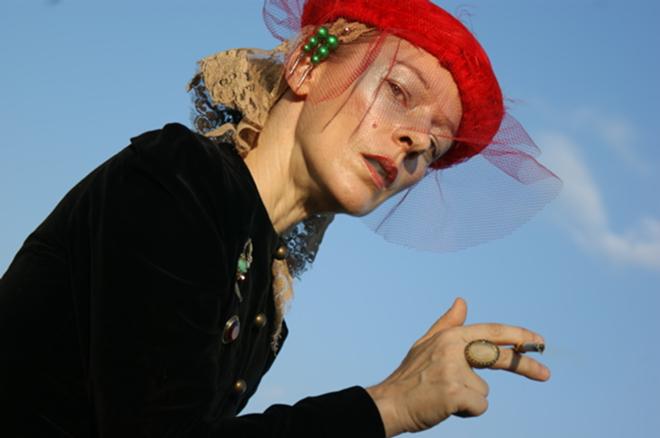From a ghostly gray background, a partially lit face bathed in blue emerges. A visage creased with lines bears a slightly down-turned expression and eyes that confront the viewer with unapologetic frankness, as if saying, “Here I am — take it or leave it.” If artist Thomas Murray’s “Black and Blue” portraits can be said to have a formula, this is it. Exceptions exist — the crinkle of a smile on this countenance or that — but face after face in the series shares something with the others that’s hard to pin down.
Among those familiar with Murray’s work, the soul-searching portraits have acquired a kind of cult status. (Before he moved to Edinburg, Tex., two years ago, the Bay area native was heavily involved in the local visual arts community.) Though they often take a backseat to his more frequently exhibited paintings — large-scale canvases that explore pattern in an efflorescence of lush colors — the “Black and Blue” series has won fervent admirers. Most fans have already fallen in love by the time they learn what links each subject in the poignant portrayals: the experience of addiction.
This weekend, Murray’s moving portraits become the inspiration and the backdrop — literally — for an unconventional, one-woman performance by St. Petersburg artist Alice Ferrulo at the Studio@620 titled Portraiture: In Three Movements. After encountering Murray’s paintings on display at St. Petersburg College about a year ago (and again at John F. Germany public library in downtown Tampa), the performer — who bills herself as an “image maker” and variously merges dance, theater, music, visual art and film in her productions — approached the painter about a collaboration.
Murray was intrigued. Ferrulo’s concept — to invent a kind of loose-knit life story around two of the portraits and perform it as a series of abstract moments rather than a straightforward narrative — dovetailed with his own aim of highlighting the universality of addiction and its attendant suffering. (Indeed, Murray maintains that the portraits are only superficially about overcoming substance abuse, though his subjects are former alcoholics and drug users; what’s really at stake, he says, is humanizing a stigmatized group and realizing that we all share the human capacity for pain and self-destruction.) He gave Ferrulo the go-ahead.
“Being an artist is about having faith and trust in other artists,” Murray says. “And so when Alice suggested this to me, I said, ‘OK — I don’t know what this is going to look like, but let’s go there.’”
Over the course of a few months, Ferrulo, Murray and his partner, artist Donna Sweigart, went there —brainstorming a nebulous biography for a character named Olivia, whose tribulations and evolution were subsequently distilled by Ferrulo into a series of “images” composed of movement, sound and visual stimuli. The results are meant to be tantalizingly ambiguous. For example, when Olivia — embodied by Ferrulo — appears on stage with blood staining her legs, it won’t be clear if the blood symbolizes menarche, the loss of virginity or an abortion, the performer says — or if it serves as a metaphor for all those female rites-of-passage and more. That complexity, Ferrulo suggests, makes the story as much about what viewers read into it as what she intends it to mean.
The number 3 serves as a unifying theme: three stages in Olivia’s life depicted in three episodes with three musical compositions (by Bach, Brahms and Janis Joplin). On stage, audiences will see the work of three visual artists working in tandem with Ferrulo’s performance: Murray’s portraits, an elaborate costume by Rogerio Martins (a student at the International Academy of Design and Technology and a frequent participant in Wearable Art at the Dunedin Fine Arts Center), and a ruff-like collar by Sweigart, whose cutting-edge jewelry has been exhibited at Florida Craftsmen Gallery.
As it happens, Portraiture will mark Ferrulo’s third production at the Studio@620 under the umbrella of her recently formed company, Black Horse Theatre (blackhorsetheatre.com). Audiences can expect to see more of her work in the future at the venue, where she is currently serving as artist-in-residence — three more works in fact, she says: performances based on texts by Simone de Beauvoir and Samuel Beckett as well as another original production like Portraiture.


